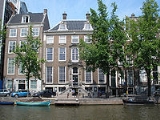
Museum Willet-Holthuysen
Encyclopedia
Museum Willet-Holthuysen is a museum
in Amsterdam
, the Netherlands
, on the Herengracht canal. It is the only fully furnished canalside patrician house in Amsterdam that is open to the public. The museum has a large collection of silverware, plates, and books from the Dutch Golden Age
. It also has a substantial collection of art.
. The last private owner, Mrs. Willet-Holthuysen, bequeathed the entire house to the city of Amsterdam on condition that it became a museum in 1895. The curator named in that year was Frans Coenen Jr., a writer, composer, and art critic. It has been a museum ever since.
, though these have been sourced from other buildings in Amsterdam. Decorative pieces by Jacob de Wit were at some stage in the house, but previous owners took them with them. It is not clear if some of the current Jacob de Wit paintings are 'back home'. Flower paintings are on display by various Amsterdam painters, such as Adriana Johanna Haanen.
Museum
A museum is an institution that cares for a collection of artifacts and other objects of scientific, artistic, cultural, or historical importance and makes them available for public viewing through exhibits that may be permanent or temporary. Most large museums are located in major cities...
in Amsterdam
Amsterdam
Amsterdam is the largest city and the capital of the Netherlands. The current position of Amsterdam as capital city of the Kingdom of the Netherlands is governed by the constitution of August 24, 1815 and its successors. Amsterdam has a population of 783,364 within city limits, an urban population...
, the Netherlands
Netherlands
The Netherlands is a constituent country of the Kingdom of the Netherlands, located mainly in North-West Europe and with several islands in the Caribbean. Mainland Netherlands borders the North Sea to the north and west, Belgium to the south, and Germany to the east, and shares maritime borders...
, on the Herengracht canal. It is the only fully furnished canalside patrician house in Amsterdam that is open to the public. The museum has a large collection of silverware, plates, and books from the Dutch Golden Age
Dutch Golden Age
The Golden Age was a period in Dutch history, roughly spanning the 17th century, in which Dutch trade, science, military and art were among the most acclaimed in the world. The first half is characterised by the Eighty Years' War till 1648...
. It also has a substantial collection of art.
History
The house was built for Jacob Hop, mayor of Amsterdam, around 1685. He was not the last mayor to own the house. In 1739 the outside was redesigned to look as it does today, in the highly fashionable Louis XIV styleFrench Baroque and Classicism
17th-century French art is generally referred to as Baroque, but from the mid to late 17th century, French art is more often referred to as Neo-classicism, which implies an adherence to certain rules of proportion and sobriety uncharacteristic of the Baroque as it was practiced in Southern and...
. The last private owner, Mrs. Willet-Holthuysen, bequeathed the entire house to the city of Amsterdam on condition that it became a museum in 1895. The curator named in that year was Frans Coenen Jr., a writer, composer, and art critic. It has been a museum ever since.
The house
Three floors are open to the public, the souterrain, with the kitchen and garden (restored in 1972), the first floor (bel-etage with long hallway), and the top floor, with one bedroom on display and rooms for exhibitions. In the blue room, several paintings on the walls show previous owners (by unspecified artists). In this room there are also several decorative paintings by Jacob de WitJacob de Wit
Jacob de Wit was a Dutch artist and interior decorator who painted many religious scenes.-Biography:De Wit was born in Amsterdam, and became famous for his door and ceiling paintings. He lived on the Keizersgracht in Amsterdam, and many of the buildings on the Keizersgracht still have door or...
, though these have been sourced from other buildings in Amsterdam. Decorative pieces by Jacob de Wit were at some stage in the house, but previous owners took them with them. It is not clear if some of the current Jacob de Wit paintings are 'back home'. Flower paintings are on display by various Amsterdam painters, such as Adriana Johanna Haanen.
External links
- Museum Willet-Holthuysen (official website)

